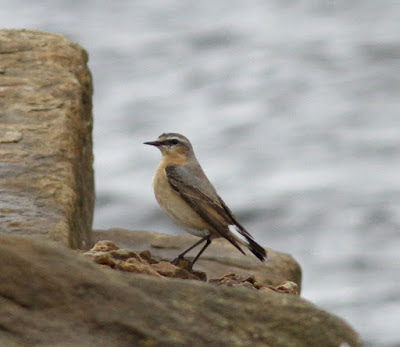male Ringed Plover
Mondays interesting Wheatear
Sundays male Greenland Wheatear
A very wet morning at Fly Flatts with drizzle and rain throughout on a W>4 at 8 degrees.
The afternoon was dry and bright with blue skies and sunshine at 11 degrees.
One of those mega quiet days today with Swallows and Swifts being the highlight early morning with Swallows moving through >S low over the water whilst Swifts skimmed through low over the fields >N.
2 Ringed Plover, 3 Common Sandpiper and 2 Oystercatchers were all I could munster on the wader front whilst otherwise it was down to 2 Raven, 1 male Reed Bunting and a Kestrel, plus the usual species.
Sundays male Greenland Wheatear was still present in the field by the top gate but keeping distant and in heat shimmer. This bird is very brightly coloured with full peach belly, a real bruiser of a bird.
Mondays Wheatear had moved on but was an interest to MC. The bird had a very poor, pale plumage which I thought was a possible start or finish of a very late or very early moult though it is completely the wrong time of year.
Mick says the reason for the coverts/primaries to show brown is that it has still retained juvenile feathers making it a 1st summer female due to brown upper parts. He says it could also show a hint of Greenland despite the shorter wings, and reading up, and as Mick says, a bird with 5-6 wing tips can still be a Greenland but more likely an intergrade Icelandic.
Checking up today its surprising how many intergrade Icelandics pass through at this time of year, late spring and late autumn on their return.
Many thanks once again to Mick for taking the interest and sharing his knowledge.
BS










